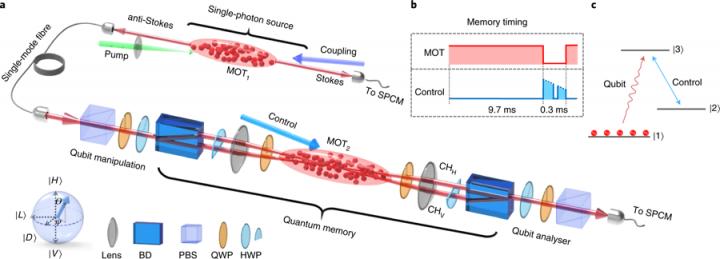
Credit: The Hong Kong University of Science and Technology
Like memories in computers, quantum memories are essential components for quantum computers – a new generation of data processors that obey quantum mechanics laws and can overcome the limitations of classical computers. They may push boundaries of fundamental science and help create new drugs, explain cosmological mysteries, or enhance accuracy of forecasts and optimization plans with their potent computational power. Quantum computers are expected to be much faster and more powerful than their traditional counterparts as information is calculated in qubits – which unlike the older units (bits) used in classical computers, can represent both 0 and 1 at the same time.
Photonic quantum memories allow for the storage and retrieval of flying single-photon quantum states. However, production of such highly-efficient quantum memories remains a major challenge as it requires perfectly matched photon-matter quantum interface. Meanwhile, the energy of a single photon is too weak and can be easily lost into the noisy sea of stray light background. For a long time, these problems suppressed quantum memory efficiencies to below 50% – a threshold value crucial for practical applications.
Now for the first time in history, a joint research team led by Prof. DU Shengwang from the Department of Physics and William Mong Institute of Nano Science and Technology at HKUST; Prof. ZHANG Shanchao from SCNU who graduated his PhD study at HKUST; Prof. YAN Hui from SCNU and a former postdoctoral fellow at HKUST; as well as Prof. ZHU Shi-Liang from SCNU and Nanjing University, has found a way to boost the efficiency of photonic quantum memories to over 85% with a fidelity of over 99%.
The team created such a quantum memory by trapping billions of rubidium atoms into a hair-like tiny space – those atoms are cooled down to nearly absolute zero temperature (about 0.00001 K) using lasers and magnetic field. The team also found a smart way to distinguish the single photon from the noisy background light sea. The finding brought the dream of an ‘universal’ quantum computer a step closer to reality. Such quantum memories can also be used as repeaters in a quantum network, laying the foundation for a new generation of quantum-based internet.
“In this work, we code a flying qubit onto the polarization of a single photon and store it into the laser-cooled atoms,” said Prof Du. “Although the quantum memory demonstrated in this work is only for one qubit operation, it opens the possibility for emerging quantum technology and engineering in the future.”
The finding was recently published as a cover story of the authoritative journal Nature Photonics – the latest of a series of research from Prof Du’s lab on quantum memory, first begun in 2011.
###
Media Contact
Jamie Wong
[email protected]
Related Journal Article
http://dx.



